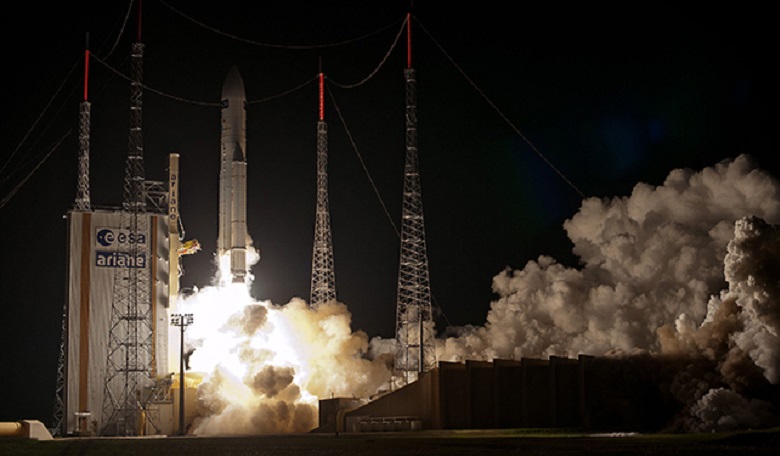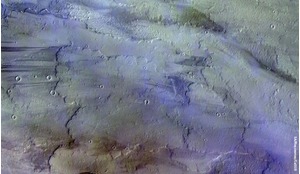On the morning of 12 December 2002, I arrived at my office and noticed that Andrea Accomazzo, my deputy Spacecraft Operations Manager, was in the room next door to the office of Manfred Warhaut, the Rosetta Ground Segment Manager. He called me in and asked if I knew? Seeing the expression on my face he realised I didn’t know what he was talking about and so he told me that Ariane 5 had experienced a launch failure the night before. This was the last Ariane 5 launch before Rosetta, which was in preparation for 13 January 2003, and a launch failure at this stage could mean a long launch postponement for Rosetta and we were very concerned.
Waiting for more concrete news, the project and industry teams in Kourou, French Guiana, continued to prepare the spacecraft for launch, and we did the same, completing our simulations programme.
However, Manfred pulled out from his files a memo that summarised the results of the work carried out by our mission analysts, listing five potential alternative candidates to the baseline mission to comet Wirtanen. This work had been requested years before by the project manager but kept secret to avoid any potential speculations about launch delays. On that very day, Manfred asked mission analysis to look at those alternative candidates and prepare for working on them.
A launch failure at this stage could mean a long launch postponement for Rosetta and we were very concerned
We had planned the last simulations such that we could give the mission control team members the possibility of a short Christmas break. The teams were released shortly before Christmas but on 1 January 2003 all the team leaders were already back in the European Space Operations Centre (ESOC), meeting to review the plan for the last preparation activities before launch. We were still go for launch and all very motivated, even though the pressure and workload were still quite high.
In the evening of 6 January, Manfred and I travelled to Berlin for a special public event organised by ESA and DLR, the German Space Agency, to present the Rosetta mission. When we arrived in Berlin we realised that everyone unofficially knew what was not yet publicly announced: ESA would cancel the Rosetta launch due to the on-going investigations on the December Ariane 5 failure because the risks of launch were considered too high without a full explanation of the causes of the recent launcher failure.
A public announcement was made on the following day. Manfred and I, back in Darmstadt, called the mission control team members for a meeting in room D217, at the heart of the interplanetary missions control centre. It was a very difficult moment, similar to the one we had both experienced a few years earlier, when Cluster was destroyed during the first Ariane 5 mission.
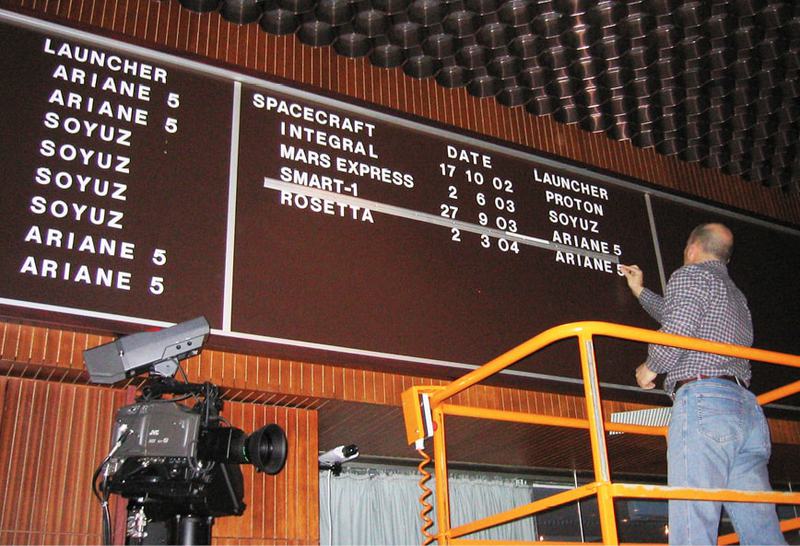 The name of Rosetta is added to the history board in the ESOC Main Control Room.
The name of Rosetta is added to the history board in the ESOC Main Control Room.
The team knew the bad news but we had to try and keep the spirits high. We all knew that a launch cancellation meant losing the target comet, and that there was no guarantee at this stage that we could find a viable alternative mission. I knew many of our colleagues had made plans for their professional and private lives which were linked to the timely launch of Rosetta. Even a launch delay of a few months would probably mean that my team at the next launch opportunity would not be the same as the one I had today.
It became clear that Ariane 5 had done a perfect job, delivering Rosetta very close to the nominal escape interplanetary trajectory
In the next few days the instructions from ESA management became clear: we had to find a new mission, a new target comet and a new trajectory that would allow a launch within the next 2.5 years. Of course the necessary amount of fuel for the trajectory manoeuvres, the maximum and minimum distance from the Sun and Earth could not differ too much from the ones of the original trajectory to Wirtanen, and the mission duration had to be similar to the nine years of the original one. Finally, the comet itself had to be similar in size, and in any case not larger than 2-3 km radius (Wirtanen’s radius was estimated at 0.6 km).
Not only did our mission analysts have to find a solution in the next few weeks but also the spacecraft team in Kourou was facing an unexpected scenario: Rosetta was fully fuelled and could not remain in this state for too long: they had to invent a safe way to remove the fuel from the tanks before the spacecraft could be put into storage.
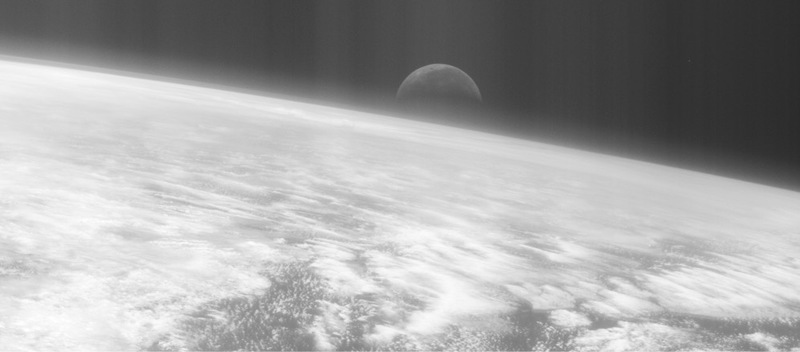 Moonrise over the Earth taken by the Rosetta NAVCAM during the first Earth swing-by in March 2005.
Moonrise over the Earth taken by the Rosetta NAVCAM during the first Earth swing-by in March 2005.
The launch cancellation, however, had also positive impacts. In particular, the new version of the spacecraft’s onboard software, already prepared for an in-flight upload in July 2003, could be finalised and burned into the spacecraft PROM memories while still on the ground.
Also, we had time to go through a thorough validation of the new onboard software with the engineering model (EQM), which was in the meantime transported and installed at the ESOC premises, where it would stay for the whole duration of the mission as a test, training and troubleshooting tool. This allowed our flight control team to participate in the test and validation campaign, with major improvements in their knowledge of the spacecraft functions and in the variety and realism of the test scenarios.
In the spring of 2003, after having examined all five mission candidates and eliminated most of them, the new target comet and mission trajectory were selected and approved: launch would be at the end of February 2004 (12.5 months later), mission duration one year longer (due to an additional Earth swing-by in the first year of flight). The target would be 67P/Churyumov-Gerasimenko, a larger comet than Wirtanen, with an estimated radius of 2 km.
This posed a significant stress on the team, and at the end of the year we were all quite exhausted
The new mission meant that we had to re-think some of our mission phases. In particular, a major difficulty would occur at the time of the Mars swing-by, now planned for February 2007: in the new trajectory Rosetta would fly in the shadow of the planet, which would mean operating for 24 minutes without sunlight on the solar arrays. The spacecraft was originally designed to fly always in sunlight, as this was the case for the trajectory to Wirtanen.
Fortunately, Rosetta was equipped with three small batteries, to cover some launch scenarios in which the launcher would carry it through Earth eclipse, so we could count on at least two of them being available and healthy after three years of flight.
However, the onboard software had to be configured such that the lack of sunlight on the arrays would not be interpreted as a failure by the fault detection and recovery logic. Also the whole swing-by scenario had to be re-designed to establish a spacecraft configuration that would minimise power consumption whilst in the shadow. It was not an easy task but we had three years to come up with a solution and we were confident we would find one.
In October 2003 the launch campaign restarted, both in Kourou and at our control centre in Darmstadt. As expected, we had to absorb a few important changes in the team. For instance, Sylvain Lodiot, our expert for the mission control system, left ESOC during the year.
Overall, however, the turnover situation was not as bad as originally feared. In fact, thanks to the launch of Mars Express in June 2003, an interplanetary probe that had inherited many of the Rosetta subsystems and had a very similar onboard software, some of the Rosetta team members could be utilised on that mission while waiting for the new Rosetta launch opportunity, and their expertise did not get lost.
So the new simulations campaign was conducted with more robust onboard software and ground systems. Thanks to the months of practice with the EQM and also to the in-flight experience gained with Mars Express, the flight control team was also more experienced and well prepared.
After two aborted launch attempts on 26 and 27 February, the first one due to bad weather conditions and the second one due to a launcher problem, on 2 March 2004 we finally saw the Ariane 5 rocket lifting off in the dark of the Kourou night.
After a ride of more than two hours on top of the rocket, the tension in the Main Control Room was relieved when we received the first radio signal from Rosetta: the spacecraft was there, in a perfectly healthy state and talking to us.
When our flight dynamics team provided the first estimations of the injection trajectory it became clear that Ariane 5 had done a perfect job, delivering Rosetta very close to the nominal escape interplanetary trajectory. This allowed us to save about 180 kg of the fuel we were carrying onboard, so that we could use part of it for performing two asteroid fly-bys during the cruise, while keeping the rest as a precious reserve for the long flight. Years later we would realise how vital such an additional reserve would be for the success of the mission.
The first months of the flight were spent in checking out all onboard systems and the scientific payload. The spacecraft worked perfectly, with only some surprises in the thermal behaviour, which we could solve by updating our operation procedures and modifying some onboard software routines. One exciting phase was the reaching of the closest point to the Sun in May 2004, down to 0.88 Astronomical Units (AU). The minimum distance of 132 million km on 24 May was only by 0.03 AUs, about 4.5 million km closer than the minimum distance planned in the Wirtanen mission. However, this was enough to heat up the side of the spacecraft exposed to the Sun to much higher temperatures than originally planned, close to the operating limits of various spacecraft units.
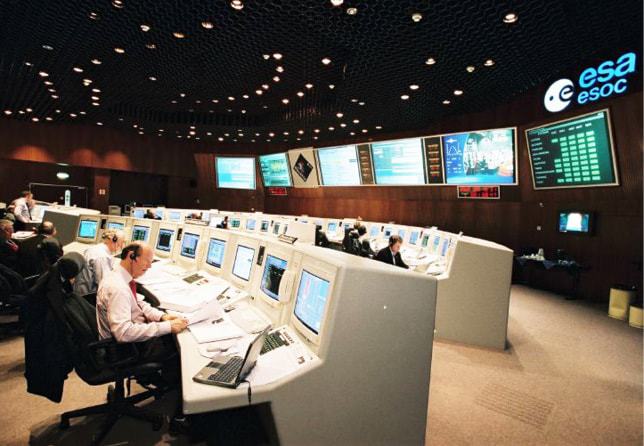 ESOC Main Control Room during Rosetta LEOP on 2 March 2004.
ESOC Main Control Room during Rosetta LEOP on 2 March 2004.
After the initial critical phases, Andrea Accomazzo also left the team to take care of the Venus Express mission preparation. He remained though in the interplanteary division, in the same corridor and working on a spacecraft very similar to Rosetta.
Critical activities during the whole of 2004 were mainly conducted at night, as Rosetta was flying towards the Sun and we were using the New Norcia ground station in Australia to maintain radio contact with Earth.
This posed a significant stress on the team, and at the end of the year we were all quite exhausted. After completion of the in-flight commissioning phase, in November 2004, we were looking forward to a quieter period of a few weeks until Christmas, after which we would start the preparation for the first Earth swing-by.
Rosetta decided to remind us that we had a long and difficult journey ahead of us
But Rosetta decided to remind us that we had a long and difficult journey ahead of us: during a small trajectory correction manoeuvre at the end of November an unknown bug in the onboard software triggered a switch of the spacecraft into safe mode, forcing us to spend several hours on recovery work during the night.
And just one week later another software bug, linked to the triggering of the first safe mode, caused a second safe mode switching and another long night of recovery operations. Both problems were quickly identified and resolved - but we now had a clear indication that our coming years would not be as easy as we would have hoped.
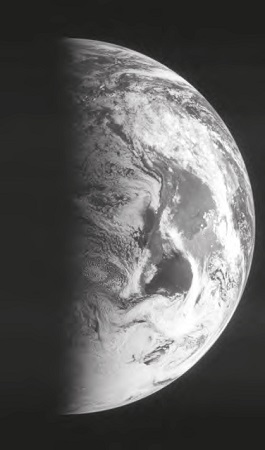 Earth seen from 250,000 km - taken by Rosetta NAVCAM when leaving Earth after the first swing-by in March 2005.
Earth seen from 250,000 km - taken by Rosetta NAVCAM when leaving Earth after the first swing-by in March 2005.
The first Earth swing-by was planned for March 2005, exactly one year after launch. We took the opportunity of the favourable geometric conditions to use the Moon as an extended target in the field of view of the Navigation Cameras to test, at least partially, the so-called Asteroid Fly-by Mode. This was an attitude control mode that we planned to use in flight only for the two short fly-bys of asteroids Steins in 2008 and Lutetia in 2010.
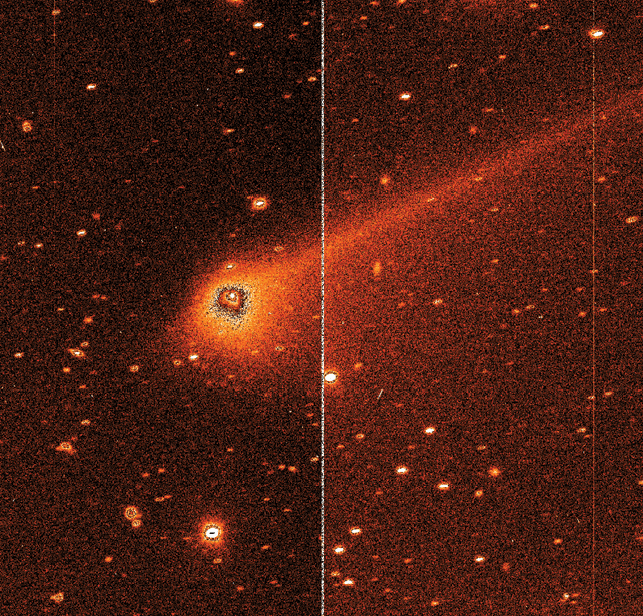 The new target - Comet 67P Churyumov- Gerasimenko imaged from ground telescopes in 2003.
The new target - Comet 67P Churyumov- Gerasimenko imaged from ground telescopes in 2003.
All these activities kept us busy for months of preparation but were eventually carried out quite successfully. At the end of March 2005 Rosetta was leaving Earth for the second time - this time into a larger heliocentric orbit towards Mars, which we would reach in February 2007. With the first long quiet cruise arc in front of us, the real interplanetary journey had finally started.





